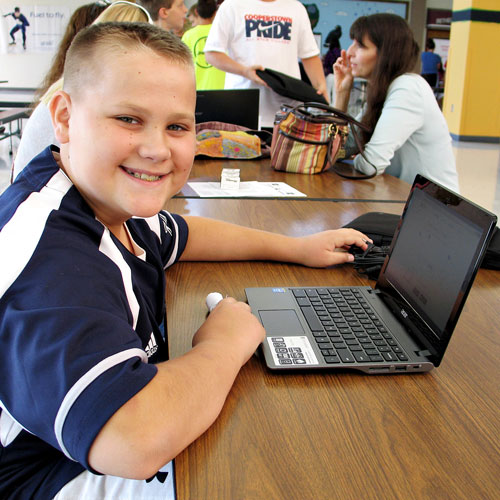The “one student, one device” learning initiative is something the Bethel Park school district has wanted to do for a long time. Before we did this, we tried a bring-your-own-technology (BYOT) device system. The problem with that is that everyone has something different, and some people don’t have anything at all. How do you take a student who comes to class with a fifteen-inch MacBook and put them alongside a student that has a traditional cell phone and say that BYOT works? You’re working with the lowest common denominator: the three students who don’t have any technology.
97%
Bethel Park School District students that have access to the Internet at home
74%
Bethel Park students that share a computer with someone in their homes, as opposed to accessing the Internet via their own devices
We decided to use BrightBytes, a research platform that specifically helps school districts assess the technology readiness of their user base. We gave a link to everyone—students, teachers, and parents—and one of the things we learned is that 97 percent of parents and families have access to the Internet at home, but 74 percent of students share a computer with somebody. So if a teacher gives a student homework that involves access to a website, they can’t do it if parents are using the computer. That was a eureka moment.
One of the main challenges with integrating technology into the education system is that the way students learn has been changed by the web. The way everyone learns has been changed by the web, so people aren’t so reliant on teachers as experts anymore. Schools have to keep up. We try to meet students where they are already, which is having immediate access to learning. The way we do that is by putting a device into the hands of every student.
It shifts the paradigm for how we consume education. Traditionally, students learn by lining up in a row and the teacher writes on a chalkboard. The kids consume the information and spit it back out to prove they learned it. Now, students create their own learning, and teachers help them through that process. Teachers are still the authority, because they have the ability to guide understanding, teach how to discern good information from not-so-good information, and help students come to well thought-out conclusions. Students want to pay attention, because they are part of what’s happening. Every student is a contributing part of the process. It’s not just a device for every student—it’s a cultural change in the way we work.
In July 2012, we decided we’d be a Google Apps and Docs district, so we’ve spent the last two years migrating over from Microsoft Exchange. Every student from kindergarten to twelfth grade has an e-mail address at Bethel Park, so students can e-mail each other and their teachers. Teachers can make documents and share them with students, create assignments, and collect them all virtually. Teachers use Hapara—one of many classroom management tools—to assign or quickly look at the history of any document and see what students contributed, so there’s also a visibility into the collaboration that didn’t exist before.
This will propel us to a different mode of instruction, where we will be able to divorce or separate the need for students and teachers to be in a single place at a single time. In a traditional classroom, how much working remotely are students asked to do? None. In our model, every student is able to work remotely. Most jobs today involve working remotely. People in the workforce have been dealing with it for some time now, and it’s coming to our kids. Do we proactively bring it to them, or wait for it to hit them when they graduate and they won’t be prepared for it?

